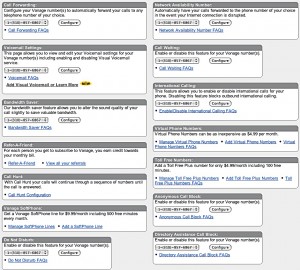by David Strom
As I mentioned in another Tiplet post on VoIP services for businesses, one of the best things about using a Voice over Internet Protocols (VoIP) phone service is a whole bunch of features that are included as part of the base package, features that normally you pay extra for if you use your ordinary local phone company. Let’s explore some of them that are available from Vonage to give you an idea of what you have in store for yourself.
But before we take our tour, one thing to note. Since I have been a Vonage customer for many years, I have had the pleasure of never having to talk to their customer service people anytime I want to change the features of my phone service. Normally, you have to call your phone company business office, wait on hold and then wait some more while they tell you how much what you want to do is going to cost. All of that is eliminated with VoIP service.
Also available from the Web is a list of the most recent calling activity both inbound and outbound – no more waiting for your monthly itemized bill from your phone company. If you mouse over the phone number, you will see the caller ID information too. This is very handy if you are trying to track down a number from a caller. Another handy feature is the ability to get your voice mail in one of several different methods. You can get an email or a text message on your cell phone that just tells you if you have a message waiting for you. The email can also contain the recorded message as a WAV file attachment. And for an extra fee (one of the few things that Vonage charges extra for), you can get your messages transcribed and sent to you too.
David Strom is an expert on Internet and networking technologies who was the former editor-in-chief at Network Computing, Tom’s Hardware.com, and DigitalLanding.com. He currently writes regularly for PC World, Baseline Magazine, and the New York Times and is also a professional speaker, podcaster and blogs at strominator.com and WebInformant.tv.
